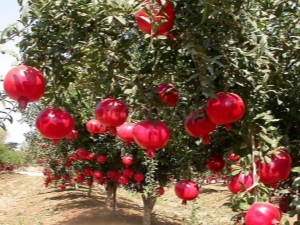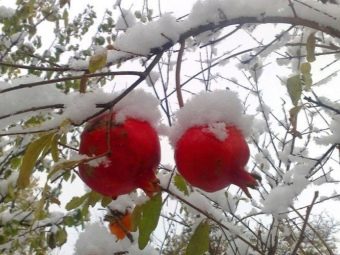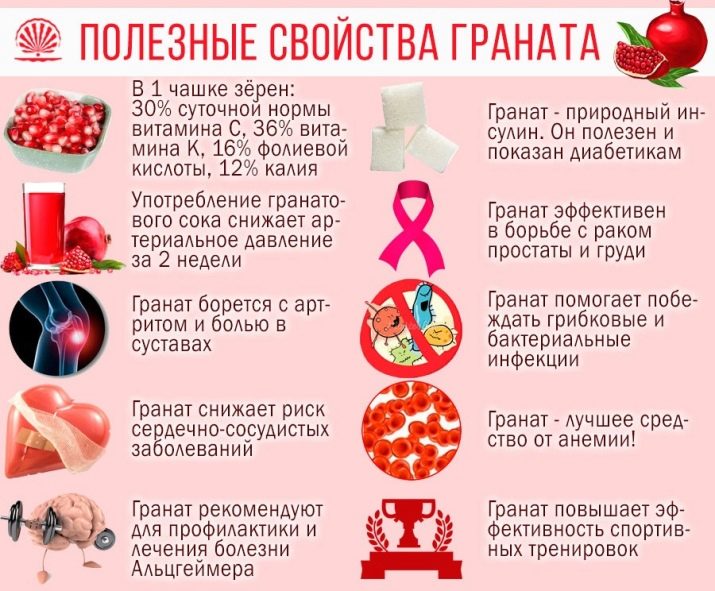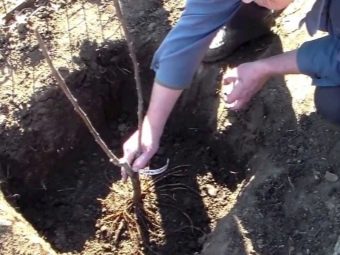Where and how does pomegranate grow?

Gardeners do not want to confine themselves to well-known cultures and choose only what grows so well in Russia.The cultivation of exotic plants is a kind of challenge to the skill of people, their ability to overcome adverse circumstances. This challenge is fully revealed when choosing a pomegranate, but it can be grown quite successfully in the conditions of central Russia.
Special features
Even the ancient civilizations, finding pomegranate trees in nature, quickly appreciated its advantages and began to grow purposefully. But initially this fruit belongs to the subtropical climate, which directly influenced how it grows. Exotic fruits can be collected wherever there are optimal conditions for the type of soil and climate. Even in the southern regions and republics of our country, farmers have successfully grown pomegranates, including those outside greenhouses. There are only three types of this plant:
- wild, it grows now only on the island of Socotra in the Indian Ocean and is unsuitable for culture;
- ordinary pomegranate (the one that grows in nature and is the basis of garden culture);
- dwarf type (it is used as a compact houseplant).
In addition to wood, pomegranate can also be a shrub, its height is limited to 5 m. Almost always, the ends of the branches end in prickles, this “protection” of cultural varieties is modeled on its wild-growing analogues. The leaves are painted in bright green color, they have a length of up to 80 and a width of up to 20 mm. In the tropical belt, pomegranate is evergreen, and already in subtropical regions with moderately cold winter months, autumn leaf fall is observed. How a plant responds to growing in a room is determined by the level of insolation and air temperature.
From the age of three, you can already see flowering and enjoy the fruits. Flowers remain long, the first time they appear in the spring and remain almost until the end of August. Under favorable conditions, you can admire individual flowers until half of September. Indoor varieties of plants, if you care for them carefully, are able to bloom almost year-round. Flowers that do not have ovaries look like a bell, and those that give fruit are closer in shape to the jug
Like the wild fruit, almost all fruit varieties have bright, red flowers; ornamental subspecies have red, white and variegated mixed colors. The plant belongs to the number of self-pollinated, the interval between flowering and fruit readiness is from 120 to 150 days. But at the same time suitable conditions must be maintained - air heating to at least 25 degrees. The fruit is unique; it is not for nothing that botanists even introduced it into their classification under a special name, the garnet.
Spherical fruits are completed with a corona-like corona, which is opposite to the stem. Rough peel is inedible, it has a transition from brown to red or dark red. In the pulp of the seeds are hidden, for the most part also reddish with a dark shade, although there are also light, and altogether pink. You can find fruits in gardens with different flavors - from sweet to sour and mixed; even in the most southern regions of the Russian Federation, the harvest cannot ripen earlier than September. Sometimes the process is delayed until November, there is a high risk of cracking of untimely picked fruits, especially if there is not enough water.
The average weight of a fruit in a cultivated plant varies from 0.2 to 0.25 kg, but if we talk about the most perfect large-fruited varieties, it can reach 0.5-0.8 kg. On large plantations with serious care, it is possible to collect up to 60 kg of pomegranates per season from each tree or shrub. Duration of fruiting can exceed 100 years, and the harvest can be left for several months in a dry cool place with a normal air passage. Compared with other subtropical crops, pomegranate tolerates frost well, and there are varieties that can survive a cooling down to 15 degrees for a short time.
However, it is worth the temperature to fall to 18 degrees for more than a few minutes, as the ground part immediately and inevitably perishes; if the frost is still increasing, the tree or bush will no longer be saved.
Pomegranate "loves" the light, is pretty good in drought. But it is experiencing; without normal watering, even surviving plants can only produce very small fruits. Soil poverty with minerals is permissible, but unacceptable:
- salinization;
- waterlogging;
- approach of groundwater to the surface.
In its natural habitat, pomegranates can be found in the lower mountain range, where it populates stone-covered slopes. Among them, the plant most prefers sediment of sand and pebbles along river banks. If climate conditions are favorable, a tree is formed. Slightly higher in the mountains - and it is already possible to find only shrubs. Hypothermia or lack of light can cause leaf fall.
In winter, the plant is best moved to a room where the temperature is maintained from +6 degrees and above.
Growing conditions
Pomegranate grows in many different countries. It can be found in Brazil and in northern Africa, in European countries (the Mediterranean). Azerbaijani and Turkish agriculture cannot do without this valuable fruit. Such trees are found in the gardens of Georgia. But even in such a northern country as Russia, they are also grown; sustainable culture exists in the Crimea, Dagestan, Krasnodar.
The northernmost point where pomegranate is cultivated on an industrial scale is the shores of the Sea of Azov. But gardeners are experimenting with a subtropical guest in central Russia, and even in the Moscow region. Trees will grow well in an open area rich in light and open to the passage of air. With a lack of any of the three main factors you can never wait for flowering, not to mention fruiting. The pomegranate finally ripens only against the background of a long hot summer, which at least partly places it in conditions close to those that exist in the fruit’s homeland.
In the countries of the Mediterranean region, pomegranate bushes are used to decorate garden space. But such an application requires sophisticated care. The Central Asian nations have grown pomegranate since ancient times, many specific varieties with excellent taste have been created. But still affects the location of these places in the depths of Asia, far from the seas. Almost everywhere in the winter it is necessary to use the shelter of the bushes, which are low, with earth, straw at a layer thickness of at least 20 cm.
No less a long tradition is the cultivation of pomegranate and south of the Caucasus Mountains. There, too, a lot of effort has been invested in the formation of specific varieties; judging by the reviews, Armenian and Azerbaijani breeds are more valuable than Georgian and Abkhazian subspecies. Near the seas, pomegranate often turns out to be a tree and winters in the open. Around the mountain belt, it is covered in the same way as in Central Asia.
On the territory of the Crimea and in the Krasnodar Territory pomegranate bloom occurs in May, the fruits can be collected in October.
Sorta
The tree that produces such delicious fruits is divided into a number of species, more precisely, varieties. Each of them has both weaknesses and strengths. The largest collection of varieties is concentrated in the Crimean Nikitsky Botanical Garden (up to 350 varieties). Among them pay special attention to themselves:
- characterized by a sweet tart taste "Sharodi" and "Halva" (Iranian);
- dwarf growth of small-fruited Japanese Punicagranatumvar;
- Central Asian "Achik-Don", "Kyzym" or "Ulf";
- pitted American "Vanderful".
However, the Russian varieties of pomegranate are no less popular than those developed by foreign breeders. They ripen early, give a significant quality crop. The advantages of such varieties are highly appreciated even abroad.If you want to choose a small home-grown variety, it is better to pay attention to “Baby”, which grows to a maximum of 0.5 m. Gardeners note that this variety blooms beautifully, and in the fall it partially loses its leaves.
Another specifically homemade type is Carthage, which, due to a haircut, can be limited to a height of 0.6-0.7 m. But if you do not cut bushes, the crown becomes outwardly ugly, in addition, the frequency of flowering is reduced. Fruits appear every year if there is enough water and light. In terms of sweetness, the Ahmar variety occupies good positions, the bushes of which can grow up to 4 m. The flowering covers the second half of summer.
Close to it (also Iranian), the Nar-Shirin variety resembles that of Ahmar, it is distinguished by a pale peel on the outside and a beige inside. If you want to grow the sweetest pomegranate, you need to choose the Indian variety "Dholka". Fruit sizes are relatively small, their weight varies from 0.18 to 0.22 kg. The height of the shrub reaches 2 m, the length of the leaves is 40-50 mm. Crossed Chinese pomegranate is attractive because these varieties do not usually have seeds, and if they are, they are soft.
A similar species was first bred in the United States, and breeders and gardeners from foreign countries immediately picked it up. Pomegranates on the concentration of vitamins and minerals do not differ from conventional varieties. But the energy value decreases sharply - by about 20%. It is very easy to get juice from fruit that does not contain seeds. The appearance of the fruit does not allow you to confidently determine whether there are seeds inside or not.
The only "tip" is a relatively light and thin skin. Because of her transport of fruits should be as careful as possible, otherwise they will easily crack. The seedless pomegranate varieties bred for European countries survive the winter period well, and produce a strong harvest during the summer months. The popularity of such fruits is growing steadily. Apparently, they will soon supplant traditional varieties containing hard grains.
Even frost-resistant pomegranate varieties should not be grown at a winter temperature of less than 15 degrees. Regardless of the formal resistance to cold, winter shelters have to be used. Usually the branches are burlap, and the earth surrounding the trunk is covered with humus or straw.
Occasionally practiced warming laid tires. Ground for backfilling should be collected from the rows.
Beneficial features
It is no coincidence that pomegranate got the nickname of the king in the fruit world. It contains a significant amount of trace elements and organic substances that can be safely recommended to any person. There is a positive effect of pomegranate on the nervous system, its help in the fight against overweight, its role in the prevention of a number of infectious disorders. In need of dietary nutrition, this fruit, with its high nutritional value and low energy saturation, will also be quite useful. Dried and crushed pomegranate (or rather, its partitions) becomes a good basis for soothing teas.
Grains can be consumed both fresh and in salads. Juice or drink by itself, or diluted with water to compensate for its saturation. It is recommended to use pomegranate for the treatment of diarrhea and the fight against anemia, to reduce the pressure and restore the function of the thyroid gland. It strengthens the body’s immune defense and fights against such a terrible disease as bronchial asthma, anemia and iron deficiency anemia. The combination of vitamins and organic acids in this plant allows us to consider it a great helper for the elderly.
Harm
The danger is any use of pomegranate for self-treatment. Even if it is used not instead of drugs or other methods of therapy, but with them, you still need to coordinate this practice with doctors.Only they can understand the compatibility or incompatibility of pomegranate and prescribed drugs, assess whether it will affect the quality of diagnosis of diseases. In addition, we must not forget that the concentration of active substances in garnets is very high, and it is easy to prevent overdose. Especially if you take vitamins in tablets, micronutrient tablets at the same time.
Strictly avoid consumption of pomegranate should be suffering from pancreatitis in the acute stage and high acidity (heartburn). It is incompatible with any ulcerative digestive disorders. This fruit badly affects the condition of those suffering from constipation, personal intolerance or allergies. Problems may also arise in those who suffer from disorders of the teeth and oral mucosa. In all these cases, eating pomegranate and drinking juice is permissible only with the permission of the doctor, and patients with other disorders should be consulted.
In any case, the very pulp of the fruit and the juice obtained from it should not be given to children under 12 months. There are also a number of chronic disorders that will worsen under the influence of substances present in the composition of the pomegranate. Caution should be used pomegranate drink tormented by the increased sensitivity of teeth. If the child is between the ages of 1 and 7 years old, you need to give only squeezed juice at home, and that in a diluted form.
After eating a pomegranate, you should immediately rinse the mouth and brush your teeth.
How to grow?
You can even grow pomegranate at home from the bone. To obtain a large number of fruits in this way will not work, but at least the aesthetic advantages and pleasant aroma will delight the owners. The greatest height of the tree reaches 0.9-1 m. Flowering occurs abundantly, lasts a long time. Flowers bloom in inflorescences, and separately from each other.
Pomegranate from the stone blooms and bears fruit at least three years after planting. It is recommended to choose a place where the light will be bright, but at the same time diffused; under the influence of direct irradiation, the leaves are covered with burns. To get good bones, you should take large format fruits that are notable for their outer beauty. The presence of rotten areas, dents and bumps, fungal lesions is unacceptable. Of each pomegranate, only a few grains are left for planting, since their germination is close to 100%.
Pulp is removed from seeds by rinsing under running water. Selected grains must be strong, all soft, green-colored seeds are unsuitable for work. The selected seed should be put for 12 hours in a special solution of stimulating preparations. If the primer is not yet ready, it can be prepared just by impregnating with stimulants. Instead of what is bought in flower shops, shops and markets, it is allowed to use the composition of self-preparation, which is formed from:
- peat;
- fertile land;
- sand.
Tanks for seedling of garnet grains are introduced into the soil by 10-15 mm. They are sprinkled with earth, sprayed with a spray of warm liquid and covered with plastic wrap. Shoots appear approximately in 12-16 days (in November or in the initial period of spring), when planted in a different period, it will take months for the shoots to come out. When seedlings arise, taras with seedlings are exposed to the light, controlling that the earth does not desiccate. The best method of irrigation - the use of a spray.
Since pomegranates tend to superficial placement of the roots, they grow well in containers of shallow depth. But be sure to take care of drainage. Young bushes and trees should be watered copiously and regularly as soon as the earth mixture dries. We must not forget that all the water accumulated in the pan should be immediately removed.
If landing is done in winter, enhanced lighting is required.
Cultivation in open ground is understandably less predictable than in confined spaces.Up to a certain stage (when it is time to plant the plants in the garden or orchard) the approach may be the same. Although the demand for soil is low, it is better to plant a pomegranate on:
- water permeable loam;
- gravel;
- calcareous earth (all three species must be powerful and saturated with humus).
Fruiting becomes full in the 7th year after moving to a stable place. In case of adverse conditions, this may occur a little later. It is best to plant a grenade on the southern segment of the site, where there is the least danger of the wind. The recommended time is the third quarter, because it is then that the most roots are formed and the survival rate increases. It is required to leave no more than 6 developed trunks for each bush, if we ignore this restriction, the size of fruits will be reduced.
Breeding
Propagate the pomegranate can be cuttings and stones. Using seeds means long-term development of the seedling, cuttings develop faster. Regardless of the specific method of cultivation required to engage in a thorough watering and fertilize the land. A quality sapling is one that is covered with strong tree bark and has at least 6 buds. Proper soaking and rational cutting of seed increase the efficiency of grafting.
Cut pomegranate seedlings should be careful that the base of the bushes is not broken. The best time to prepare - the beginning of autumn, immediately after harvest. It is recommended to apply annual shoots, getting rid of side branches and exhausted spines.
Shoots are planted in trenches and covered with damp earth, covered with straw. The expedient period for planting cuttings is May, just at this time they should reach the necessary condition.
To learn how to grow a pomegranate by yourself, see the video below.






















































